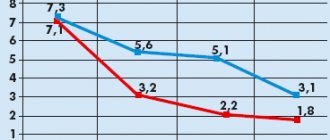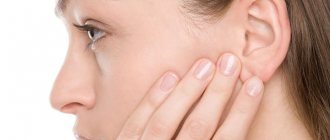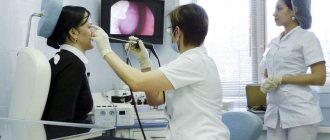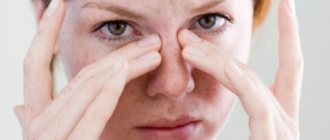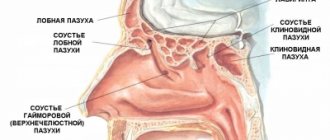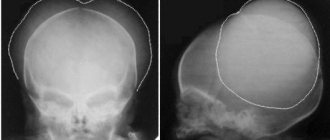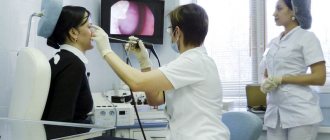Causes
In children, the disease develops after:
- adenoids;
- rubella;
- scarlet fever.
The causative agents of laryngotracheitis are microbes and viruses that cause acute respiratory viral infection. If timely treatment is provided, there will be no complications.
Basically, laryngotracheitis is a complication of viral infections:
- adenovirus;
- influenza virus;
- parainfluenza;
- measles;
- chicken pox and others.
Laryngotracheitis has bacterial causes and conditions of occurrence, and is a consequence of infection, for example, streptococcus, staphylococcus. With weak immunity, bacteria will join the viruses, which will lead to the occurrence of this disease and other troubles.
General information about tracheitis
Trachea
- the longest organ of the respiratory tract, in the form of an air tube (7-11 cm), lined with ciliated epithelium, which connects the larynx and bronchi. When an infectious pathogen or allergen enters the body, the thin mucous membrane of the trachea begins to become inflamed, and an unproductive painful cough occurs.
Inflammation of the trachea can be primary (an independent disease, rarely encountered in practice) or secondary (as a consequence of an infectious or allergic lesion of the respiratory tract).
Primary develops infrequently; it is mainly a combined pathology:
- laryngotracheitis
- inflammatory lesion of the larynx along with the trachea; - rhinopharyngotracheitis
- damage to the mucous membranes of the nose, pharynx, trachea; - tracheobronchitis
is inflammation of the bronchi along with the trachea.
There are several reasons for the occurrence and development of the disease:
- Viral origin – the causative agents are ARVI, parainfluenza, and influenza viruses.
- Bacterial infections - caused by pneumococcus, Staphylococcus aureus, Haemophilus influenzae, etc. Bacterial tracheitis is much more complex and more dangerous than viral tracheitis, because bacteria provoke purulent inflammation of the trachea, leading to the development of a retropharyngeal abscess.
- Allergic background - the body's reaction to allergens: dust, wool, pollen, cosmetics, household chemicals, perfumes.
The disease is transmitted by airborne droplets if it is of viral origin. It is almost impossible to get infected with bacterial, fungal, allergic tracheitis.
Symptoms
Signs appear after a person feels that he is unwell. The patient has:
- the temperature rises sharply;
- tickle in the throat;
- a little viscous and thick sputum is released;
- the voice becomes hoarse and hoarse.
There is discomfort in the larynx, burning and drying. A painful, dry, barking cough begins to torment. It becomes this way because there is swelling and spasms of the vocal cords. When coughing, the pain behind the sternum begins to worsen. Its attacks appear when a person inhales frosty or dusty air, breathes deeply or laughs.
When the disease enters the chronic stage, the symptoms become less pronounced and periods of decline are observed. A patient with chronic laryngotracheitis has a headache, a sore throat, and a change in voice. He doesn't want to do anything; he feels a lump in his throat. Before you say anything you have to clear your throat.
Complications
Laryngotracheitis may well lead to the development of complications; one of the most common and widespread is tracheobronchitis. It develops if treatment was untimely or was not completed.
Against the background of a chronic or too long illness, pneumonia can occur. The patient is subject to hospitalization due to increased intoxication. There is a risk of respiratory failure.
With frequent exacerbations of the chronic form or a protracted disease, tissue begins to grow. This can lead to the formation of benign tumors of the mucous membrane.
Asphyxia is considered a serious complication when the body does not receive oxygen. If it continues for a long time, fainting will occur and death will occur.
The disease can be aggravated by the appearance of narrowing of the lumen of the larynx. Presenters, artists and teachers whose profession involves speech and voice may experience disability.
Complications in the youngest children are the most serious. Their lumen of the larynx is anatomically narrow, and when they are sick, sputum also accumulates in it. This is what causes spasms in the laryngeal muscles. This condition can lead to the development of an acute inflammatory process of the larynx - false croup, which poses a threat to life.
Treatment
Laryngotracheitis in adults and children does not require hospitalization of the patient, with the exception of cases of false croup in young patients.
In the acute form or during exacerbation of the chronic form, the patient is advised to drink large amounts of fluid. The person should be in a warm room with sufficiently high air humidity.
If viral laryngotracheitis has been diagnosed, treatment is carried out using antiviral agents. Bacterial and mixed types of disease are treated with antibiotics.
Treatment of symptoms of laryngotracheitis consists of prescribing drugs that suppress cough, reduce temperature, as well as antihistamines and mucolytics, electrophoresis and inhalations.
In the chronic form, immunomodulatory therapy, vitamin C, multivitamin complexes, carbocesteine, electrophoresis with the use of drugs, UHF, inhalation, massage and inductotherapy are indicated.
In some cases, surgical treatment is performed. This happens when drug therapy does not help get rid of the disease. In addition, surgery may be indicated if there is a threat of developing a malignant tumor.
Classification
Laryngotracheitis, depending on the type of pathogen, is divided into:
- infectious;
- bacterial;
- mixed.
The nature of the disease can be acute or chronic. The acute form lasts from a week to 20 days. If the treatment is competent, the disease will go away without leaving a trace. In the second case, the illness can last for a very long time - months and years, and from time to time it will worsen.
Depending on changes in the anatomical structure of organs, the disease is divided into:
- catarrhal – mild form;
- atrophic – moderate;
- hyperplastic – severe form.
Respiratory compensation is a pathological condition in which the maintenance of blood gas composition is not ensured; the disease occurs:
- Compensated. The body is able to cope with laryngotracheitis on its own.
- Incomplete compensation. Treatment with medications is necessary.
- Decompensated. Surgery is required.
- Terminal. Oxygen starvation sets in.
Folk remedies
It is usually possible to achieve complete recovery from laryngotracheitis in 7-10 days if you follow the doctor’s prescriptions and follow general recommendations, including the use of folk remedies:
- inhalations with soda;
- inhaling steam from boiled potatoes;
- inhalations with healing essential oils: fir, juniper, eucalyptus, tea tree oil.
The medicinal properties of onion inhalations and decoctions of onion pulp are described. There is a healing anti-inflammatory effect of honey and garlic mixed with various herbs, roots, fruits and plants.
The herbs of St. John's wort, wild rosemary, oregano, coltsfoot, plantain leaves, mullein and nettle flowers, marshmallow and licorice roots, and fennel fruits have a positive effect. Radish juice with honey, potato and beet juice, a decoction of anise seeds, carrot juice with milk, a herd of raisins with onions will help restore your voice and ease your breathing.
Risk group
Laryngotracheitis is at risk for people who abuse alcohol and cigarettes. The risk group includes those living in places with poor ecology, as well as those with severe chronic diseases (heart, blood vessels, central nervous system, diabetes), and those who have congestive processes in the lungs, for example, bronchial asthma. People with all sorts of diseases of the nasopharynx that make breathing through the nose difficult or impossible can become infected with laryngotracheitis.
The development of the disease can be provoked by:
- eating very cold or hot food;
- tendency to allergies;
- shout.
People with reduced immunity are at risk.
Prevention of tracheitis development
Prevention of the disease consists of strengthening the immune system, creating a favorable microclimate in the home and eliminating the causes that can provoke tracheitis.
What you need to do to minimize the risk of disease:
- harden the body;
- get rid of bad habits;
- ensure optimal parameters of temperature (19-22°C), humidity (40-60%) in the room;
- avoid attending public events in the autumn-spring period;
- limit contact with allergens.
Diagnostics
In most cases, the doctor makes a diagnosis based on complaints, external examination and signs. Prescribes the following procedures:
- blood gas monitoring – measuring gas levels allows you to note oxygen deficiency;
- X-ray of the larynx;
- smear for bacterial culture.
A computed tomography scan of the larynx is performed. This is an x-ray diagnostic method that allows you to study and evaluate the condition of an organ, identify inflammatory processes, neoplasms and developmental abnormalities.
Fiber laryngoscopy is performed using an endoscope. An endoscope is a flexible device with a small camera at the end. The doctor carefully examines the mucous membrane of the trachea and larynx and determines the degree of swelling.
For prolonged chronic laryngotracheitis, endoscopic biopsy is recommended. With this disease, the tissues of the larynx change. Additional procedures are necessary to exclude other respiratory diseases.
Treatment
The patient must remain in bed, take antiseptic medications and vitamin complexes. Warm, plenty of drink is necessary; these can be compotes, tea, herbal tinctures and decoctions. Be sure to ventilate the room and humidify the air. You can’t talk a lot, it’s better to be silent altogether.
The diet should include:
- dairy products;
- fruits and vegetables crushed to a mushy state;
- liquid soups and broths.
You need to eat in small portions. It is recommended to gargle and inhale with herbal mixtures.
Severe forms of laryngotracheitis, as well as if there is no positive effect, are treated in a hospital setting. Treatment of children is carried out exclusively under the supervision of a doctor.
Therapeutic therapy consists of taking medications that have antiviral, antipyretic, and anti-inflammatory effects. Antibiotics and cough medicines must be prescribed. The throat is irrigated with local antiseptics. In order to remove phlegm, mucolytics are taken, and antihistamines are taken to relieve swelling. If there is no temperature, inhalations are carried out with mineral and alkaline solutions. To reduce spasms of the muscles of the trachea and larynx, antispasmodics are used.
The patient must follow a diet; it is forbidden to eat cold, hot, sour, salty and spicy dishes and foods. The use of folk remedies must be agreed with the attending physician. Herbs and foods will help speed up your recovery. Medicinal herbs include echinacea, St. John's wort, calendula and others. Honey is of great benefit for laryngotracheitis and other respiratory diseases. Garlic, milk, salt and soda diluted in water are very useful.
If recovery does not occur, complications develop and surgical intervention is resorted to: the cysts are excised and the lumen is enlarged.
First aid
With laryngotracheitis, it is very important to provide assistance to the sick person even before a medical visit. And the point here is not only in the own symptoms of the disease, but also in the peculiar psychological stress that manifests itself in the sick person, especially in a child.
- It is necessary to reassure the patient, since his increased excitement can provoke an increase in frequency and deepening of spasmodic attacks.
- Be sure to provide fresh air into the room.
- In case of acute laryngospasm causing suffocation, urgently induce a gag reflex using an accessible method (for example, by pressing on the root of the tongue).
- Give the patient a warm drink - milk, dried fruit compote, mineral water, preferably a slightly alkaline one. You can add a pinch of baking soda to the milk - this is very helpful in narrowing the larynx.
- The humidity in the room where the sick person is located should be high.
- Warm foot baths (water temperature - 38-40 degrees) help relieve acute attacks. However, they cannot be done against the background of elevated body temperature.
Forecast
The acute form of laryngotracheitis, which is not accompanied by complications, has a favorable prognosis. For those people whose profession is related to singing and speaking, it worsens in terms of professional unsuitability.
Full recovery can be expected after about 2 weeks. But only if the treatment is complete, comprehensive and correct.
Don’t forget that on our website you can buy oxygen concentrators at a competitive price in Moscow and St. Petersburg.
Preventive actions
The best prevention will be strengthening the immune system and timely treatment of colds. Don't forget about seasonal flu vaccination, regular walks in the fresh air, morning exercises and good nutrition. Maintain a sleep and rest schedule.
If you still have questions and need specialist help, make an appointment. The doctor will tell you how to treat chronic laryngotracheitis in a child and how to help the baby at the first signs of stenosis. Sign up on the website and by phone.
Related services: Children's consultation

